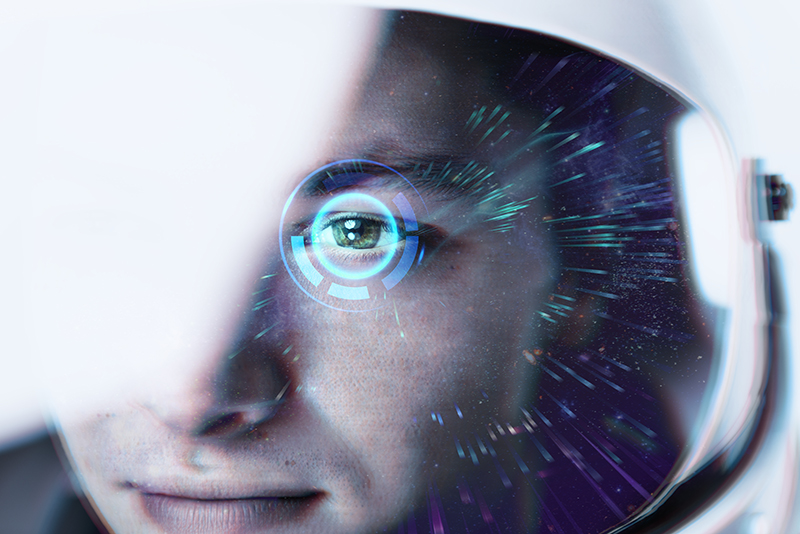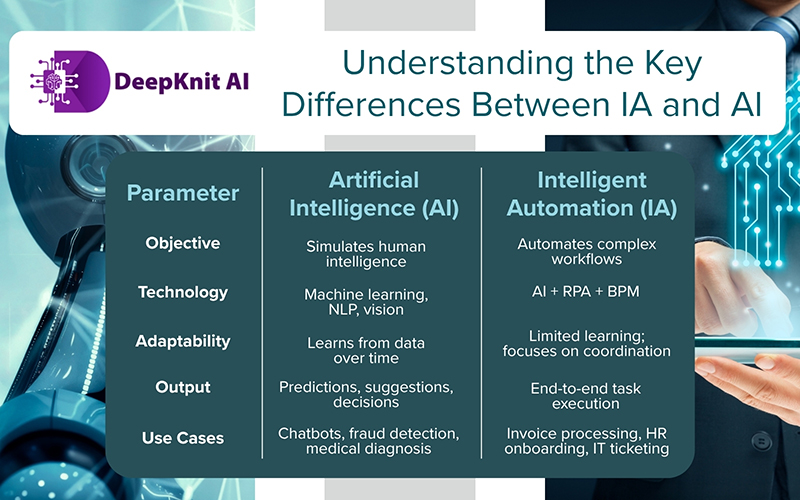Five years ago, it was estimated that by 2025, 50% of all business process automation will be automated using either Artificial Intelligence (AI) or Intelligent Automation (IA).
Currently, 48% of businesses use some form of AI to process their data and workflows. Even then, many enterprises still use the terms interchangeably; often without fully comprehending what separates them or how they uniquely transform industries.
Considering the present, digitally-accelerating landscape, understanding the difference between AI and Intelligent Automation isn’t just a matter of definition, but an inevitable aspect for enterprises to streamline their operations, enhance outcomes and stay competitive. It doesn’t matter if you’re a stakeholder, tech strategist or a simply curious individual exploring the evolving automation landscape, knowing the role of automation in business is essential. This post will break down what exactly AI and IA means, what sets them apart and how to effectively put them to use.
What Is AI?
Artificial Intelligence refers to machines and/or software programs that can simulate human intelligence. Unlike traditional automation, which follows strict rules and workflows, AI is designed to learn, reason, problem-solve, and even understand language, thereby improving over time by learning from data.
Core Capabilities of AI
- Machine Learning (ML): AI systems that learn from historical data to make predictions.
- Natural Language Processing (NLP): Enables machines to understand, interpret, and generate human language.
- Computer Vision: Allows machines to “see” and comprehend visual inputs like images or videos.
- Decision Intelligence: AI that supports or automates decision-making by analyzing data patterns.
AI is the “brain” behind modern systems, they are smart, evolving, and capable of making intricate decisions without having to be explicitly programmed for every possible scenario.
What Is Intelligent Automation?
Intelligent Automation (IA) seamlessly blends advanced AI technologies with Robotic Process Automation (RPA) to automate end-to-end business processes. While RPA takes care of the repetitive, rule-based tasks, AI handles unstructured data and more intricate workflows.
In essence, IA can be likened to automation with brains—transcending simple task repetition activities to include reasoning, judgment, and adaptation.
Key Components of IA
- RPA (Robotic Process Automation): By mimicking human actions, it takes care of repetitive digital tasks.
- Business Process Management (BPM): Handles tasks, systems and data that drives an automated workflow.
- AI (as a catalyst): AI plays a significant role in enhancing automation with learning and decision-making capabilities.
Unlike private AI systems that focus on prediction/cognition, IA is all about end-to-end workflow automation at scale.
Real-time Use Cases of Artificial Intelligence
AI has redefined several industries across the globe, ranging from healthcare to law and finance to retail. Here are a few practical examples of AI:
- Healthcare Diagnostics
AI is used on a large-scale basis for detecting anomalies in medical images, forecasting disease outbreaks, and recommending personalized treatment plans. DeepKnit AI goes a step further, leveraging proprietary contextual AI to streamline clinical documentation, medical summarization, and records extraction, thereby freeing up valuable time for medical professionals.
- Customer Service Chatbots
AI-powered chatbots provide round-the-clock customer support, handling queries with contextual understanding. Advanced AI tech like NLP and sentiment analysis make these bots smarter and more empathetic over time.
- Fraud Detection Capabilities
As AI systems continuously learn from transaction data, they develop the capability to identify and flag any suspicious behavior in real-time. This intelligent approach significantly reduces fraud in financial operations.
- Predictive Maintenance
Organizations, especially in manufacturing, use AI to anticipate machine breakdowns even before they occur, thereby saving money and reducing downtime through prompt intervention and servicing.
Real-world Use Cases of Intelligent Automation
IA is best suited for those businesses looking to streamline their end-to-end, complex workflows that involve structured and unstructured data.
- Insurance Claims Processing
IA takes care of the entire claim cycle; retrieving details from forms, doing verifications, flagging discrepancies and issuing reimbursements—all with minimal human intervention.
- Invoice Management
Organizations make use of IA to match purchase orders, extract relevant data from scanned receipts and trigger payments, reducing chances of any human error and improving efficiency.
- IT Customer Support
Regular IT support tasks like access requests, password resets, or system diagnostics will be handled by intelligent bots, thereby enabling human counterparts to focus on strategic tasks.
- HR Onboarding
Core tasks ranging from document collection to training schedule generation, IA helps speed up the onboarding process, while ensuring compliance and consistency across employees.
How AI and IA Transform Business Workflows
Just like how a team consisting of people with different capabilities contribute their powers to get things done, in machine intelligence, AI and IA can be integrated to use their varying capabilities to take care of complicated tasks. For instance:
- In healthcare, AI can be used to analyze patient data to generate a clinical summary, while IA takes the summary into the EHR system.
- In IT and other industries, an AI-powered chatbot engages at the front end to collect the queries while in the back end, IA works to resolve the issue.
DeepKnit AI (DK AI) specializes in these kinds of intuitive integrations, by blending generative AI, intelligent orchestration, and customization on the specific area of expertise to deliver real-world automation outcomes. It doesn’t matter if you are dealing with stacks of unstructured medical data or looking to automate complex document workflows, DK AI ensures that intelligence is actionable and scalable.
Final Thoughts
In a world that’s rapidly accelerating towards automation, it is inevitable to understand the differences and synergy between AI and IA, which can eventually help empower your business to make smarter tech investments and significant progress. While AI brings in intelligence and contextual understanding, IA brings scale, consistency and execution capabilities. When put together, they can open doors to a future where errors and inefficiency will be a thing of the past.
It’s Time to Think Beyond Bots –
Automate Smarter & Lead with Intelligence
Contact Us for a Demo


